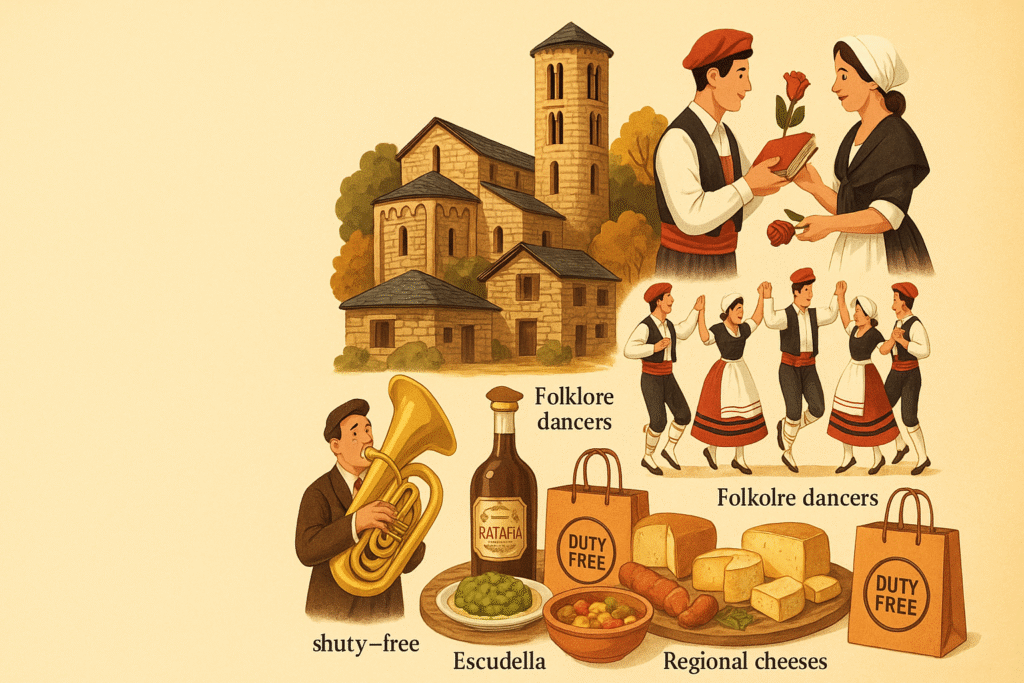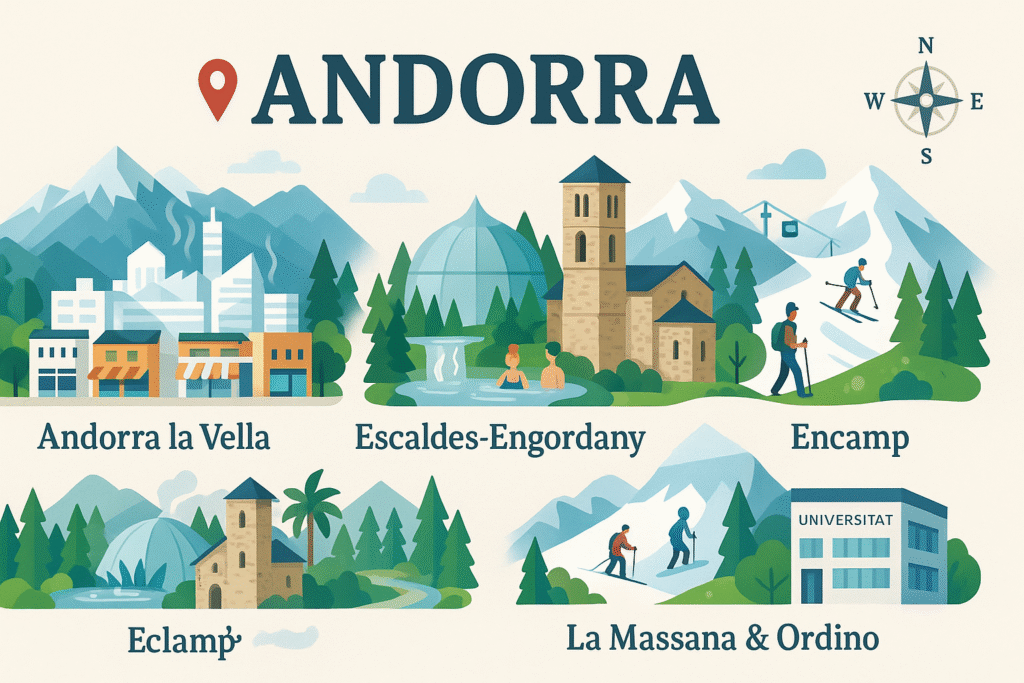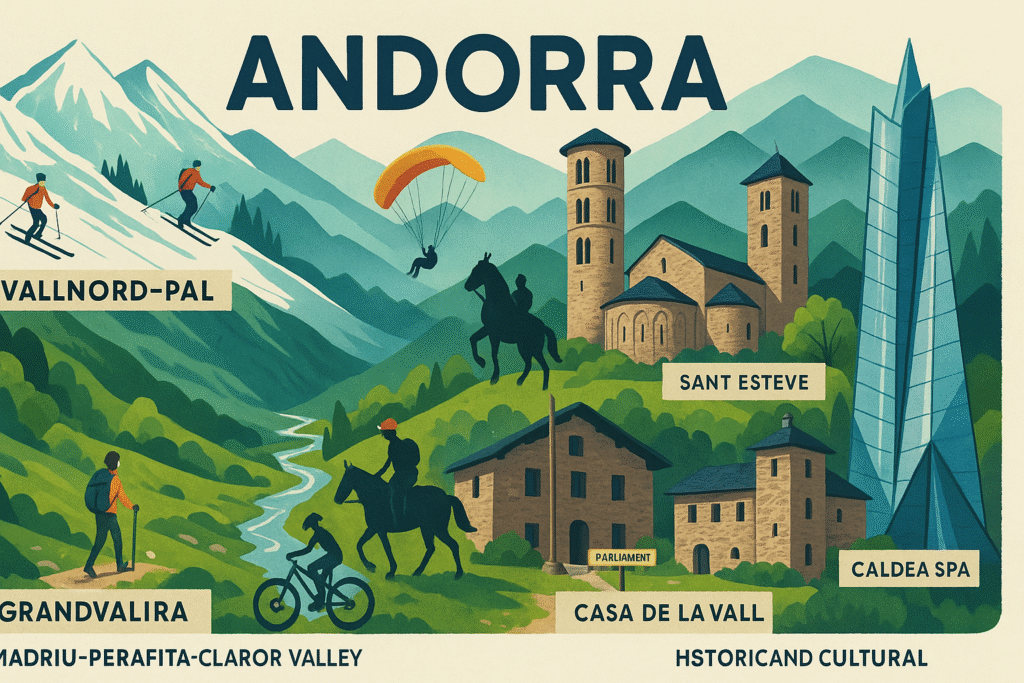1. Introduction
Andorra, a double-landlocked microstate between France and Spain, is tucked away high in the eastern Pyrenees and is well-known for its ski resorts, duty-free shopping, rich mediaeval history, and breathtaking mountain scenery. This tiny principality, which has fewer than 80,000 inhabitants but receives millions of tourists each year, offers a distinctive fusion of contemporary tourism and old-world charm.
2. Historical Overview
Beginnings in the Carolingian Era
- According to local legend, Although there is little historical evidence, Charlemagne gave Andorra autonomy in 805 AD in exchange for its assistance against Moorish forces.
- It had developed into an independent mountain region by the ninth century, defended by Frankish vassals and governed by local chiefs.
Medieval Co-Principality
- A dual sovereignty agreement between the Count of Foix (later the French head of state) and the Bishop of Urgell in Spain established Andorra’s distinct government in 1278. This arrangement still exists today, with the Spanish Bishop and the French President acting as Co-Princes.
Modern Development & Sovereignty
- formally became a sovereign state in 1993 after adopting its first constitution and becoming a member of the UN that same year.
- The late 20th century saw the start of the shift from an agrarian to a tourism and services-based economy.
- Currently, a constitutional co-principality governs a parliamentary democracy.
3. Geography & Location
Position, Area & Borders
- Europe is the continent.
- Area: 468 km², which is less than many cities’
- It is double-landlocked, meaning it is isolated within its landlocked neighbours; its borders are France to the north and Spain to the south, east, and west.
Topography & Climate
- consists of glacial lakes, deep valleys, and steep peaks; Coma Pedrosa (2,942 m) is the highest peak.
- Climate: High altitude, with warm summers for hiking and chilly, snowy winters for skiing.
4. Political Status & Global Standing
Co-Principality Explained
- Co-Princes: French President and Bishop of Urgell, Spain
- Prime Minister and Parliament: The PM is in charge of running the government, while the General Council has legislative authority.
UN & International Membership
- Member of the United Nations since June 28, 1993
- Additional memberships include ECOEUR, WHO, WTO, and the Council of Europe.
- Although it is neutral and does not belong to NATO, it has strong ties to both France and Spain.
5. Demographics & Language
- Population: ~77,000 (2025 approx.)
- Citizenship: French or Spanish nationals make up a large portion of the population; Andorran citizenship is restrictive.
- Languages:
- Catalan – official
- Spanish, French, Portuguese – commonly spoken.
- Catalan – official
- Religion: primarily Roman Catholic, with a strong emphasis on church-centered cultural rituals.
6. Culture & Traditions

Festivals & Folklore
- The Andorra la Vella Fair features artisan fairs and mediaeval parades.
- On Sant Jordi Day, people exchange books and roses to honour Catalan culture.
- Rural games and community dances are part of Encamp’s Autumn Festiva.
Art, Music & Heritage
- Stone homes, slate roofs, and Romanesque churches such as the Church of Santa Coloma are examples of Pyrenean architecture.
- brass band music, folklore groups, and traditional dances (marratxa, contrapàs).
- Cultural sites: Casa de la Vall and the Andorra National Auditorium.
Cuisine & Lifestyle
- Trinxat, escudella, grilled meats, and regional cheeses are examples of hearty mountain cuisine.
- Popular foods include cheese, cured meats (cabanes), and liqueurs (ratafia, moscatell).
- A flourishing shopping culture is made possible by duty-free status.
7. Economy & Currency
- Services-driven economy, including retail, tourism, and finance
- Currency: Euro (used through an agreement; not a member of the EU)
- Low unemployment and a high GDP per capita (~€40,000+), but it is dependent on French/Spanish policies and income.
8. Major Cities & Parishes

Andorra la Vella (Capital)
- The highest national capital in Europe (1,023 m)
- thriving retail areas, thermal springs, and historical sites like the Caldea Spa
Escaldes-Engordany
- Well-known for its spa complex, wellness tourism, and thermal springs
Encamp
- Home of the Church of Sant Romà and a major transportation hub to mountain resorts
La Massana & Ordino
- Vallnord ski area access; entry point for summer hiking
Sant Julià de Lòria
- A border town with a university campus and shops
9. Tourist Attractions

Nature & Outdoor Activities
- Vallnord-Pal and Grandvalira are ski resorts.
- Hikes in the Madriu-Perafita-Claror Valley (UNESCO Heritage) and Coma Pedrosa during the summer
- Horseback riding, paragliding, and mountain biking
Historic & Cultural Landmarks
- Santa Coloma, Sant Esteve, and Sant Joan de Caselles are examples of Romanesque churches.
- The historic house of parliament, Casa de la Vall
- The tallest spa in Europe is Caldea Spa.
10. Unique Facts
- Despite being one of the smallest countries in Europe, its GDP is high.
- Only the second nation in the world to be double-landlocked
- The Andorran coat of arms is displayed in a blue section on Andorran license plates.
- According to local legend, Charlemagne founded
- Although independent in 1278, the country has only had a constitution and joined the UN since 1993.
11. Travel Tips
- Best Time to Visit:
- Winter (Dec-Feb) for skiing
- Summer (Jun-Sep) for hiking and festivals
- Winter (Dec-Feb) for skiing
- Transportation: Buses and taxis travel on small roads; rental cars are permitted.
- Visa: Schengen-area customs; verify your passport’s requirements
- Currency:Euro is widely used, and purchases are permitted duty-free.
- Health & Safety:Extremely secure, low crime rate; emergency numbers in Spanish and French
12. Conclusion
Despite its small size, Andorra is rich in culture, history, and alpine beauty. Andorra offers a distinctive European escape, with its snow-capped peaks, mediaeval co-principality roots, lively festivals, and duty-free charm. This principality is a hidden gem just waiting to be found, whether you’re hitting the slopes, touring Romanesque churches, or enjoying wellness spa treatments.
1. Official Government and Tourism
- 🇦🇩 Government of Andorra (Govern d’Andorra)
For facts on governance, policy, and official statements. - 🏔️ Visit Andorra (Official Tourism Site)
Includes up-to-date info on attractions, events, and planning your trip.
2. International and Cultural Organizations
- 🌍 UN Member Profile – Andorra (UN.org)
Verifies Andorra’s UN membership and key facts. - 🏛️ UNESCO – Madriu-Perafita-Claror Valley
Details the UNESCO World Heritage cultural landscape in Andorra.
3. Travel and Research Sites
- ✈️ Lonely Planet – Andorra Travel Guide
Trusted travel tips, things to do, and city guides. - 🌐 Britannica – Andorra Country Facts
In-depth historical and political insights.
4. Maps and Geography
- 🗺️ CIA World Factbook – Andorra
Comprehensive country data on geography, economy, and demographics. - 🏔️ Google Maps – Andorra
For embedding or linking location-based directions.





[…] 4.Andorra: Culture, History, Nature & Travel Guide […]
[…] 4.Andorra: Culture, History, Nature & Travel Guide […]